.
6.09.2013
The duration was expected to exceed the 16-second firing during the first powered test flight in April
.
Virgin Galactic’s SpaceShipTwo today flew under rocket power for the second time, the company reported.
The suborbital spaceship took off attached to the WhiteKnightTwo mothership, which dropped it from an unspecified altitude above Mojave, Calif.
“SpaceShipTwo has once again lit her rocket motor in flight!” the company said in a Twitter message around noon Eastern time. “We can see and hear it from the ground. Photos and video coming soon.”
Another message about 10 minutes later reported that spaceship pilots Mark Stucky and Clint Nichols and had landed safely.
Virgin Galactic did not immediately provide details about how long the craft’s hybrid rocket engine, built by Sierra Nevada Corp., was fired.
The duration was expected to exceed the 16-second firing during the first powered test flight in April, which broke the sound barrier and reached 55,000 feet.
Virgin Galactic said the second flight also tested the SpaceShipTwo’s “feathered” reentry system for the first time during powered flight.
The test flights are the first in a series leading up to a first trip to space, possibly before the end of the year, and the first commercial flights of space tourists, expected next year.
.
Frams: Virgin-Galactic-Video
.

.
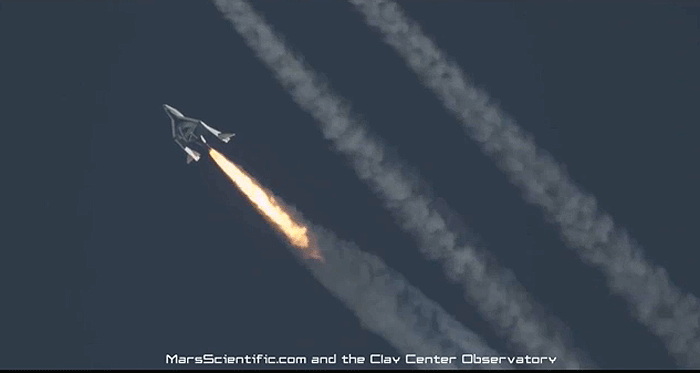
.

.

.

.
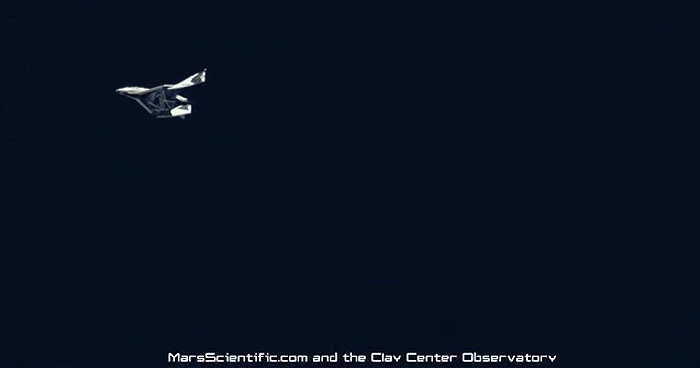
.

.
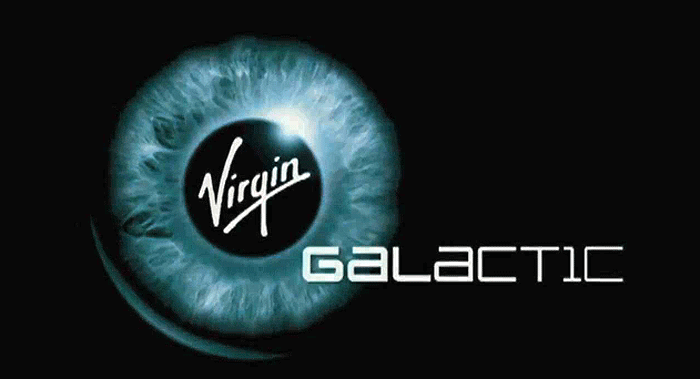
Quelle: Florida-Today
.
British billionaire Richard Branson's commercial space venture Virgin Galactic took one step closer to carrying tourists into space with its latest supersonic test flight.
On Thursday, the company's rocket plane went Mach 1.43 in the skies above the Mojave Desert. It is the second time the aircraft, named SpaceShipTwo, has broken the sound barrier.
The test flight is a key milestone in Virgin Galactic's effort to be the world's first commercial space liner, which would make several trips a day carrying scores of paying customers into space for a brief journey.
“This is a giant step,” Branson wrote in a blog post. “Our spaceship is now the highest commercial winged vehicle in history!”
During the test, SpaceShipTwo was taken to about 46,000 feet by a carrier aircraft, and nearly one hour into the flight, it was dropped like a bomb.
After a short free fall, pilot Mark Stucky and co-pilot Clint Nichols engaged the hybrid rocket motor -- powered by nitrous oxide and a rubber compound -- for 20 seconds.
SpaceShipTwo blasted to Mach 1.43, reaching about 56,000 feet in altitude.
The rocket plane flew solo for nearly 30 minutes, making a smooth landing in Mojave about 9:25 a.m.
The flight began on a desert runway at Mojave Air and Space Port, about 100 miles northeast of Los Angeles. Mojave is where the aircraft was designed and built.
Another key milestone achieved during the test was that the aircraft deployed its twin tail sections to a “feathered” position, which is designed to slow the aircraft's descent and allow it to softly return to Earth. The one-of-a-kind design is vital to reducing wear and tear on the six-person rocket ship, so it can eventually make several commercial trips each day into outer space.
It’s a novel approach. Until now, astronauts have reached space packed tight in a capsule or shuttle attached to a high-powered rocket.
Instead, Virgin Galactic will use a WhiteKnightTwo carrier aircraft that will fly with the reusable SpaceShipTwo rocket plane under its wing to 50,000 feet, where the spaceship will separate and blast off.
When the rocket motor engages, it will power the spaceship to nearly 2,500 miles per hour and take the pilots -- and up to six passengers -- to the edge of space, more than 60 miles above the Earth's surface.
Once they reach that suborbital altitude, passengers will experience weightlessness and see the curvature of the Earth. Then they will reenter the atmosphere and glide back to the runway.
The price for the experience: $250,000.
Virgin Galactic said it has accepted more than $80 million in deposits from about 630 reservations made by people who are interested in the ride.
The WhiteKnightTwo carrier aircraft, which resembles a flying catamaran because it has two fuselages, and SpaceShipTwo are still in the midst of the test-flight program, which will continue in Mojave until Virgin Galactic believes it can begin commercial operations.
Virgin Galactic hopes to reach space in test flight this year and make its first passenger flight sometime in 2014 from Spaceport America in New Mexico, where the company hopes to eventually offer the tourist trips.
Branson first hoped he would blast tourists into space by 2007, but the date has repeatedly slipped. Space experts wonder whether even 2014 is too ambitious. Virgin Galactic still needs to clear regulatory hurdles, particularly satisfying safety concerns with the Federal Aviation Administration.
On Thursday, the company's rocket plane went Mach 1.43 in the skies above the Mojave Desert. It is the second time the aircraft, named SpaceShipTwo, has broken the sound barrier.
The test flight is a key milestone in Virgin Galactic's effort to be the world's first commercial space liner, which would make several trips a day carrying scores of paying customers into space for a brief journey.
“This is a giant step,” Branson wrote in a blog post. “Our spaceship is now the highest commercial winged vehicle in history!”
During the test, SpaceShipTwo was taken to about 46,000 feet by a carrier aircraft, and nearly one hour into the flight, it was dropped like a bomb.
After a short free fall, pilot Mark Stucky and co-pilot Clint Nichols engaged the hybrid rocket motor -- powered by nitrous oxide and a rubber compound -- for 20 seconds.
SpaceShipTwo blasted to Mach 1.43, reaching about 56,000 feet in altitude.
The rocket plane flew solo for nearly 30 minutes, making a smooth landing in Mojave about 9:25 a.m.
The flight began on a desert runway at Mojave Air and Space Port, about 100 miles northeast of Los Angeles. Mojave is where the aircraft was designed and built.
Another key milestone achieved during the test was that the aircraft deployed its twin tail sections to a “feathered” position, which is designed to slow the aircraft's descent and allow it to softly return to Earth. The one-of-a-kind design is vital to reducing wear and tear on the six-person rocket ship, so it can eventually make several commercial trips each day into outer space.
It’s a novel approach. Until now, astronauts have reached space packed tight in a capsule or shuttle attached to a high-powered rocket.
Instead, Virgin Galactic will use a WhiteKnightTwo carrier aircraft that will fly with the reusable SpaceShipTwo rocket plane under its wing to 50,000 feet, where the spaceship will separate and blast off.
When the rocket motor engages, it will power the spaceship to nearly 2,500 miles per hour and take the pilots -- and up to six passengers -- to the edge of space, more than 60 miles above the Earth's surface.
Once they reach that suborbital altitude, passengers will experience weightlessness and see the curvature of the Earth. Then they will reenter the atmosphere and glide back to the runway.
The price for the experience: $250,000.
Virgin Galactic said it has accepted more than $80 million in deposits from about 630 reservations made by people who are interested in the ride.
The WhiteKnightTwo carrier aircraft, which resembles a flying catamaran because it has two fuselages, and SpaceShipTwo are still in the midst of the test-flight program, which will continue in Mojave until Virgin Galactic believes it can begin commercial operations.
Virgin Galactic hopes to reach space in test flight this year and make its first passenger flight sometime in 2014 from Spaceport America in New Mexico, where the company hopes to eventually offer the tourist trips.
Branson first hoped he would blast tourists into space by 2007, but the date has repeatedly slipped. Space experts wonder whether even 2014 is too ambitious. Virgin Galactic still needs to clear regulatory hurdles, particularly satisfying safety concerns with the Federal Aviation Administration.
Quelle: Los Angeles Times
.
Richard Branson’s Space Machine Flies Higher and Faster Than Ever Before
.
Virgin Galactic’s SpaceShipTwo completed its second powered flight this morning, flying faster and higher than any previous flights. It’s been nearly three years since SpaceShipTwo’s first glide flight, an indication of the challenges of developing a space vehicle that is safe enough for passenger flight, something that has been one of the main concerns since the sub-orbital space tourism idea kicked off a decade ago.
Today’s flight flew under rocket power four seconds longer than the first powered flight back in April, with the total burn time lasting 20 seconds after being dropped from 46,000 feet. After igniting the rocket, Scaled Composite test pilots Mark Stucky and Clint Nichols accelerated to Mach 1.43 and reached an altitude of 69,000 feet. It was the 29th flight for the future spaceliner, part of the extensive flight testing program Virgin Galactic and Scaled Composites is completing before flying the first group of more than 600 people who have signed up for the sub-orbital ride. Today’s flight also marked the first time SpaceShipTwo’s “feather” re-entry system has been tested after a powered flight.
“It was particularly thrilling to see for the first time today the whole elegant system in action during a single flight, including the remarkable feathering re-entry system,” Virgin Galactic founder Sir Richard Branson said in a statement released after the flight. “It was this safety feature more than anything else that originally persuaded us that the overall design of the system was uniquely fit for purpose.”
The long gap between powered flights follows a similar testing schedule for SpaceShipOne, Scaled Composites X-Prize winning spacecraft that flew three times into sub-orbital space back in 2004. That airplane made its first powered flight in December of 2003, and the second one nearly four months later in early April. SpaceShipTwo’s flight test program has been much more extensive, with more than twice as many glide flights before the first powered flight.
Founded by Burt Rutan in the 1980s, Scaled Composites has developed numerous unusual and cutting edge aircrafts over the years, and has always been known for its secrecy surrounding future flying plans. Sir Richard Branson, Scaled’s customer on the SpaceShipTwo project isn’t as reserved. He’s dropped a few hints about upcoming flights, and earlier this year he mentioned in an interview that the first passenger flight (with him on board) could take place on Christmas day.
SpaceShipOne did manage its first flight past the 100 kilometer altitude mark — an arbitrary, but widely accepted altitude known as the Karman line, marking the beginning of space — just over two months after its second powered flight. But the SpaceShipOne flights were designed to win the X-Prize, a $10 million dollar award for the first team to fly past 100 kilometers twice within two weeks. No passengers were on board SpaceShipOne, and it was a much more aggressive flight test program. Later in 2004 the Scaled Composites team managed to complete the two flights just five days apart, taking home the prize.
SpaceShipTwo is designed to carry passengers and is being carefully watched by the Federal Aviation Administration which will ultimately decide if the spacecraft is safe for commercial flights. Last month the FAA accepted Virgin Galactic’s application to be a commercial space system operator. Now, the agency must now decide if it will approve the license so the company can fly passengers into space. There is normally a six month window for the FAA to consider applications, but it can pause the process as needed.
One of the repeated refrains from Burt Rutan during the early days of SpaceShipTwo and the space tourism idea, long before delays pushed passenger flights back several years, was the need to make sure the entire space flight system was “orders of magnitude safer” than other space systems. Such comments made it clear for both passengers and engineers that SpaceShipTwo was not going to carry passengers until it had been tested thoroughly enough to ensure safe flight. Launching from an airplane, and Rutan’s feather system, which essentially folds the airplane in half — allowing it to re-enter the atmosphere in a fairly simple, and slow speed configuration — are two key components of increasing the safety of sub-orbital space flight.
A third component of safe space flight may be a reason for future delays: the hybrid-rocket motor. Today’s flight used the same type of nitrous oxide and rubber engine as the first powered flight and is similar to the motor used on SpaceShipOne. The hybrid motors use the nitrous oxide as its oxygen supply for combustion, and hydroxyl-terminated polybutadiene (fancy rubber) as the solid fuel. Both Scaled Composites and motor manufacturer Sierra Nevada Corporation have been working on updated motor designs, but it’s unknown whether or not a new design will be used to power SpaceShipTwo on its first test flight into space.
During a motor test in May, Scaled says it intentionally introduced flaws into a motor to “improve knowledge of different design components.” That motor was tested to failure when the engine exploded at Scaled’s test facility in Mojave — the same day Sierra Nevada Corporation tested a standard version of the hybrid motor successfully at its facility near San Diego. But other than mentioning the claimed test to failure in Mojave, there are no other details available about the motor and whether it was part of a new design.
Scaled is expected to perform several more powered flights, slowly expanding the flight envelope of SpaceShipTwo, before flying past the 100 kilometer mark for the first time. The first space flights with just test pilots on board are expected to take place in Mojave, California where Scaled Composites is based. Virgin Galactic’s passenger space flights will take place at the company’s appropriately future looking “Spaceport America” in New Mexico. But still no date on when the first passengers will enjoy the black sky of space and a bit of floating around the cabin.
Quelle: WIRED
.

.

.

.

.

Quelle: Virgin Galactic
.
Update: 10.09.2013
.
Spektakuläre Aufnahmen von Virgin-Galactic letzten Testflug von
SpaceShip Two
.
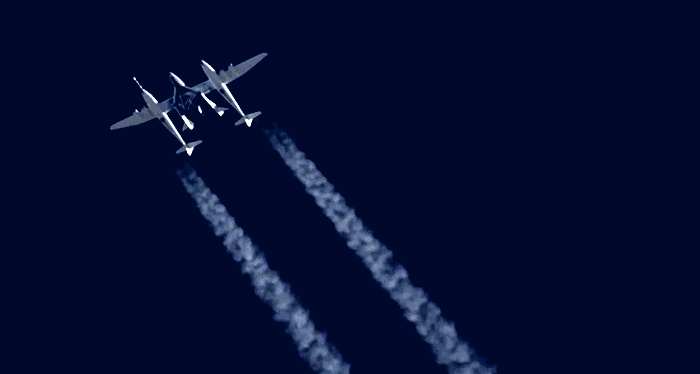




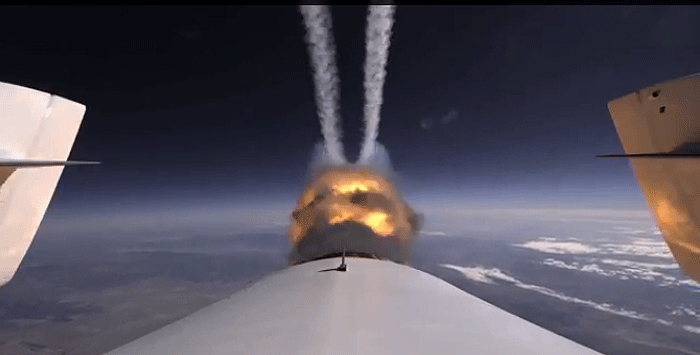
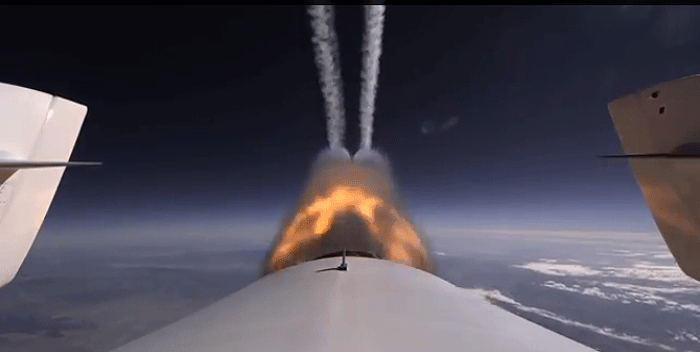

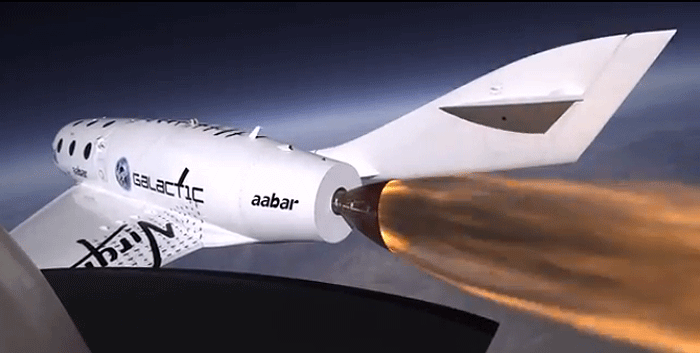
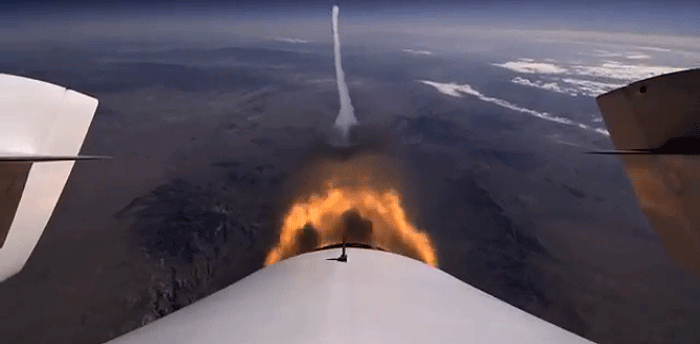

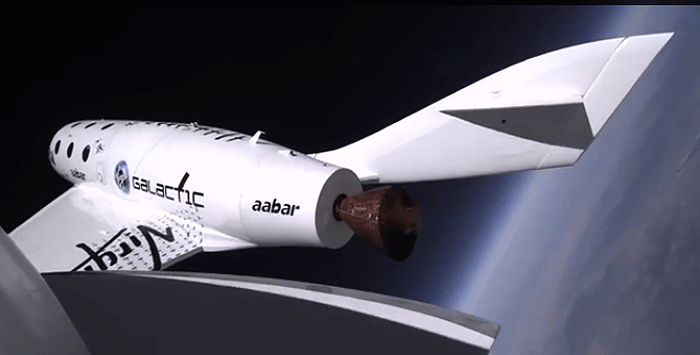







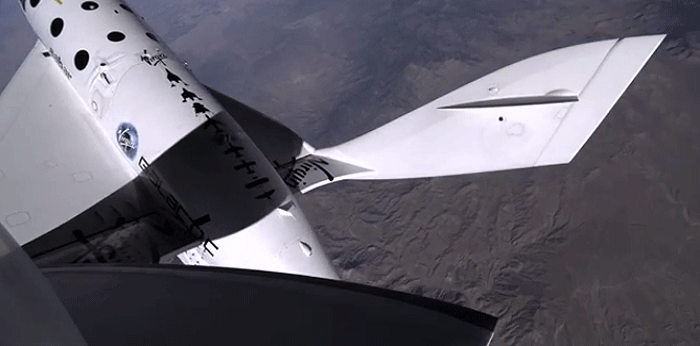






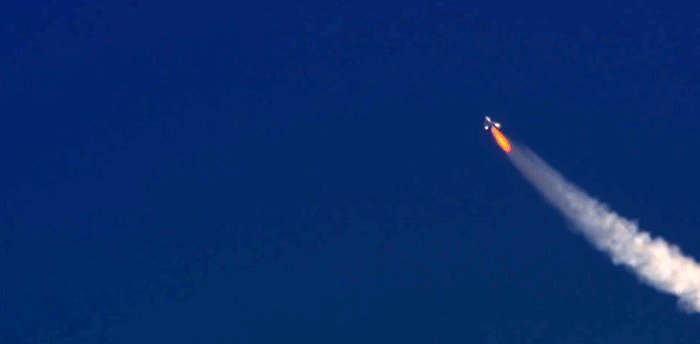
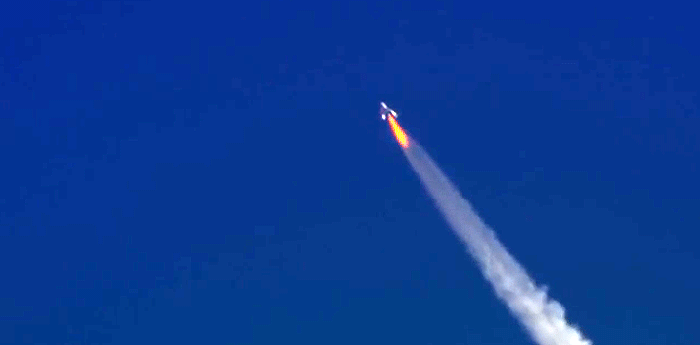
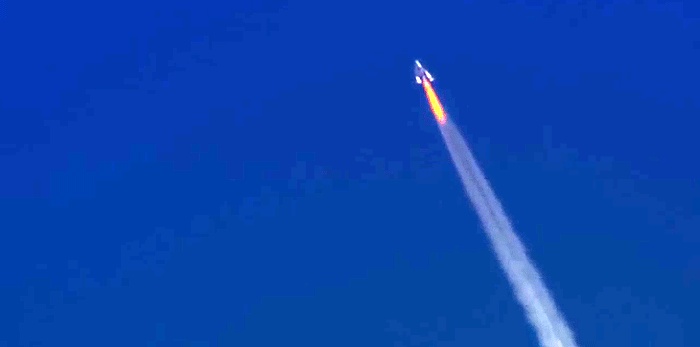
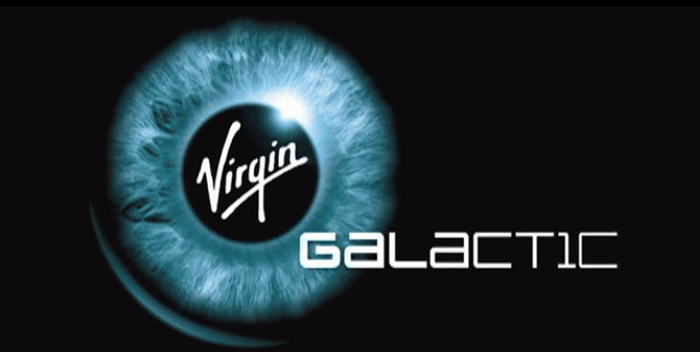
Quelle: Virgin Galactic
6275 Views
